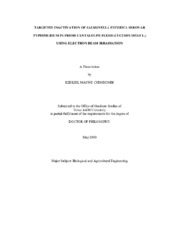| dc.contributor.advisor | Castell-Perez, Elena M. | |
| dc.creator | Chimbombi, Ezekiel M. | |
| dc.date.accessioned | 2011-08-08T22:47:28Z | |
| dc.date.accessioned | 2011-08-09T01:28:02Z | |
| dc.date.available | 2011-08-08T22:47:28Z | |
| dc.date.available | 2011-08-09T01:28:02Z | |
| dc.date.created | 2010-05 | |
| dc.date.issued | 2011-08-08 | |
| dc.date.submitted | May 2010 | |
| dc.identifier.uri | https://hdl.handle.net/1969.1/ETD-TAMU-2010-05-7656 | |
| dc.description.abstract | Food irradiation is costly in terms of the energy utilized and the time spent, therefore, it is imperative to optimize it in order to avoid sub lethal dose or an overdose both of which have detrimental effects on the quality of fresh produce such as cantaloupe. The bacterial load in fresh cut cantaloupe flesh was quantified on the basis of growth and mobility over time, and used as the basis for targeted irradiation simulation. The bacterial growth was predicted using the Gompertz model, while a power law function was used for predicting the bacterial mobility. The microbiological structure of cantaloupe flesh was assessed using Transmission Electron, Scanning Electron, and Light Microscopy as a basis for understanding the mobility of the bacteria into the internal mesocarp tissues. A plate assay was also undertaken to determine the possibility of S. typhimurium producing cell wall degrading enzymes such as polygalacturonase to gain access into intact fresh cantaloupe tissues.
S. typhimurium in fresh cut cantaloupe flesh has a lag phase duration of 7.76 hours and can reach a maximum population of 7.98 logs CFU/g in 30 hours. Cantaloupe flesh has a vast network of intracellular spaces through which the bacteria can move into the internal mesocarp tissues, particularly because S. typhimurium (LT2) does not produce any enzymes such as polygalacturonase which could be breaking down the cell wall binding structures as a mechanism for internalization into intact internal tissues. A theoretical bacterial inactivation dose estimate based on the experimentally determined D10-value and the bacterial population was used to simulate irradiation treatment of the cantaloupe flesh samples using a 10MeV electron beam irradiator (LINAC) to establish the best treatment. The optimal 10 MeV electron beam irradiation treatment for S. typhimurium internalized in fresh cut cantaloupe samples for 30 hours was determined to be a double beam with 0.5 cm attenuation of Lucite (Trademark) at the top and 3.3 cm at the bottom. | en |
| dc.format.mimetype | application/pdf | |
| dc.language.iso | en_US | |
| dc.subject | Cantaloupe | en |
| dc.subject | Salmonella | en |
| dc.subject | Typhimurium | en |
| dc.subject | Irradiation | en |
| dc.title | Targeted Inactivation of Salmonella enterica Serovar Typhimurium in Fresh Cantaloupe Flesh (Cucumis melo L.) Using Electron Beam Irradiation | en |
| dc.type | Thesis | en |
| thesis.degree.department | Biological and Agricultural Engineering | en |
| thesis.degree.discipline | Biological and Agricultural Engineering | en |
| thesis.degree.grantor | Texas A&M University | en |
| thesis.degree.name | Doctor of Philosophy | en |
| thesis.degree.level | Doctoral | en |
| dc.contributor.committeeMember | Moreira, Rosana G. | |
| dc.contributor.committeeMember | Braby, Leslie | |
| dc.contributor.committeeMember | Cisnerros-Zevallos, Luis | |
| dc.contributor.committeeMember | Sanchez-Plata, Marcos X. | |
| dc.type.genre | thesis | en |
| dc.type.material | text | en |


